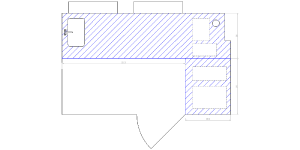Difference between revisions of "Project:Darkroom"
| Line 16: | Line 16: | ||
# Source a lab sink from somewhere. | # Source a lab sink from somewhere. | ||
# Build the benches (with a lot of help from Phil). | # Build the benches (with a lot of help from Phil). | ||
| − | # Run power sockets to the rightmost wall. | + | # Run power sockets to the rightmost wall. |
| + | |||
| + | I believe the light switch for that room is located outside of the door, this is probably unsatisfactory. [[User:Robert|Robert]] 07:42, 3 June 2011 (UTC) | ||
=== Step 2: Preparations === | === Step 2: Preparations === | ||
Revision as of 07:42, 3 June 2011
What is it?
A combined darkroom & wet room, ideal for photographers, biohackers, and other people who want to do dark, wet things. The initial goal is to get a small darkroom up and running suitable for black & white developing/printing/toning that's also usable as a mini-lab for biohacking experiments.
In the diagram to the right, you can see the wet bench along the top of the room. There's a sink at one end, and the microwave & PCR machine at the left. This bench is for all "wet work" – processing film and bio experiments. The right bench is the "dry desk", with a paper trimmer and enlarger outlined on it. We can build storage shelves in the window bays, and as the benches should be comfortable to use standing there's room underneath for storage, a fridge, and an incubator.
Where is it?
In one of the old bathrooms in Unit 23, next to the laser cutter.
What's the state of play?
We've discussed it on the mailing list, started assembling bits and pieces that will be needed, and have removed a wall & the bathroom fittings.
Next steps
(Presuming we reach a consensus that we want integrated benches and not to keep the extraction table in the dark/wet room):
Step 1: Infrastructure
- Source a lab sink from somewhere.
- Build the benches (with a lot of help from Phil).
- Run power sockets to the rightmost wall.
I believe the light switch for that room is located outside of the door, this is probably unsatisfactory. Robert 07:42, 3 June 2011 (UTC)
Step 2: Preparations
- Install ventilation (some open questions: do we just want to vent to outside? If we have airflow through the room, how are we going to deal with grime from the workshop?).
- Black out the windows, vents, and door edges completely.
- Buy any equipment needed.
- Run some test sessions & inductions to the dark/wet room.
Who's involved?
- User:alexp is the main driver of the project.
- Phil's willing to help out by building the benches.
- User:bugs was very helpful in explaining a biohacker's needs for the room.
- Others have wombled up some equipment already.
- All volunteers welcomed; you should email User:alexp if you want to get involved.
Other interested people
You should add your name here.
Shopping list
Photography
- An enlarger & lens (we have one, but it's in an unknown state and missing a lens)
- 2 Paterson tanks & reels (eBay)
- Basic black & white chemistry (developer, stop bath, fixer, wetting agent)
- 3 medium trays for print developing (ideally something like 14" by 12")
- 6x measuring cylinders
- 2x thermometers
- Print tongs
- Alligator clips (for hanging prints/films to dry)
- Chemical storage tanks (ideally burpable ones)
- A safelight
- A lock for the door (so you can bolt it from the inside to stop people blundering in and ruining your work)
- I fitted one, but then the door was replaced when the direction of it was changed - there should be a bolt on the door that was removed that can be used. Robert 07:41, 3 June 2011 (UTC)
Biohacking
A biohacker should write this section.
